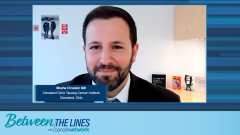
Treating Favorable Risk Patients with Renal Cell Carcinoma with Lenvatinib
Experts discuss the safety of treating renal cell carcinoma with lenvatinib within different patient risk populations.
Episodes in this series

Tom Powles, MBBS, MRCP, MD: I have 2 questions for you. The first is what did you think about the good risk population, the risk groups? And then the second question is, how do you feel about the lenvatinib [Lenvima] dosing?
Rana McKay, MD: Good questions. I think about the favorable risk patients, this is certainly an area of controversy across the board. But we are now in an era where, in my mind, if a clinician is coming to the point where they need to treat somebody with systemic therapy, and they’re making that decision, I am going to start them on treatment because not necessarily every favorable risk patient needs to start on treatment as soon as they’re diagnosed. But if you’re making that decision to go ahead and start them on treatment, the data are compelling for combination therapy as opposed to sunitinib [Sutent] monotherapy. These trials were not designed to demonstrate statistical significance in these IMDC [International Metastatic Renal Cell Carcinoma Database Consortium] subgroups. The key is looking at the direction of the hazard ratios, and looking at the long run as opposed to the short run and in my practice, I tend to choose doublets. Obviously, you’re considering patient factors, and you have that discussion with the patient about goals of care and what’s in mind, but I do think that there is sufficient data to treat favorable risk patient with combination therapy.
Tom Powles, MBBS, MRCP, MD: You articulated that nicely. My take on that is the same as yours. The lack of significant survival signal at this early stage, but remember, we’ve got the PFS [progression-free survival] and response rate is better. It suggests that in the long run, there will be benefit. One of the problems with sunitinib and pazopanib [Votrient] is in the end, we didn’t get that many long-term durable responses, and second-line nivolumab [Opdivo], yes, it’s attractive. But I don’t think it’s the same as getting really great control upfront and in terms of going into the durable emission. I genuinely don’t think that survival signal is mature enough for me. And I liked the way you put that, which is if you’re going to make the decision to get that, you don’t have to treat everyone immediately. But in those good risk patients when you decide that they need treatment, sunitinib seems a suboptimal option from my perspective. And I’ve gone through exactly what you’ve said. My patients are either on good risk with surveillance or are having stereotactic radiotherapy or whatever it might be. Or they’re having systemic therapy and that’s combination therapy. But this kind of long term sunitinib-resistant cloning, it doesn’t seem to be the right approach for me. I agree with you.
Transcript edited for clarity.
Newsletter
Stay up to date on recent advances in the multidisciplinary approach to cancer.






























































































